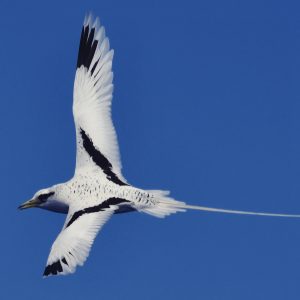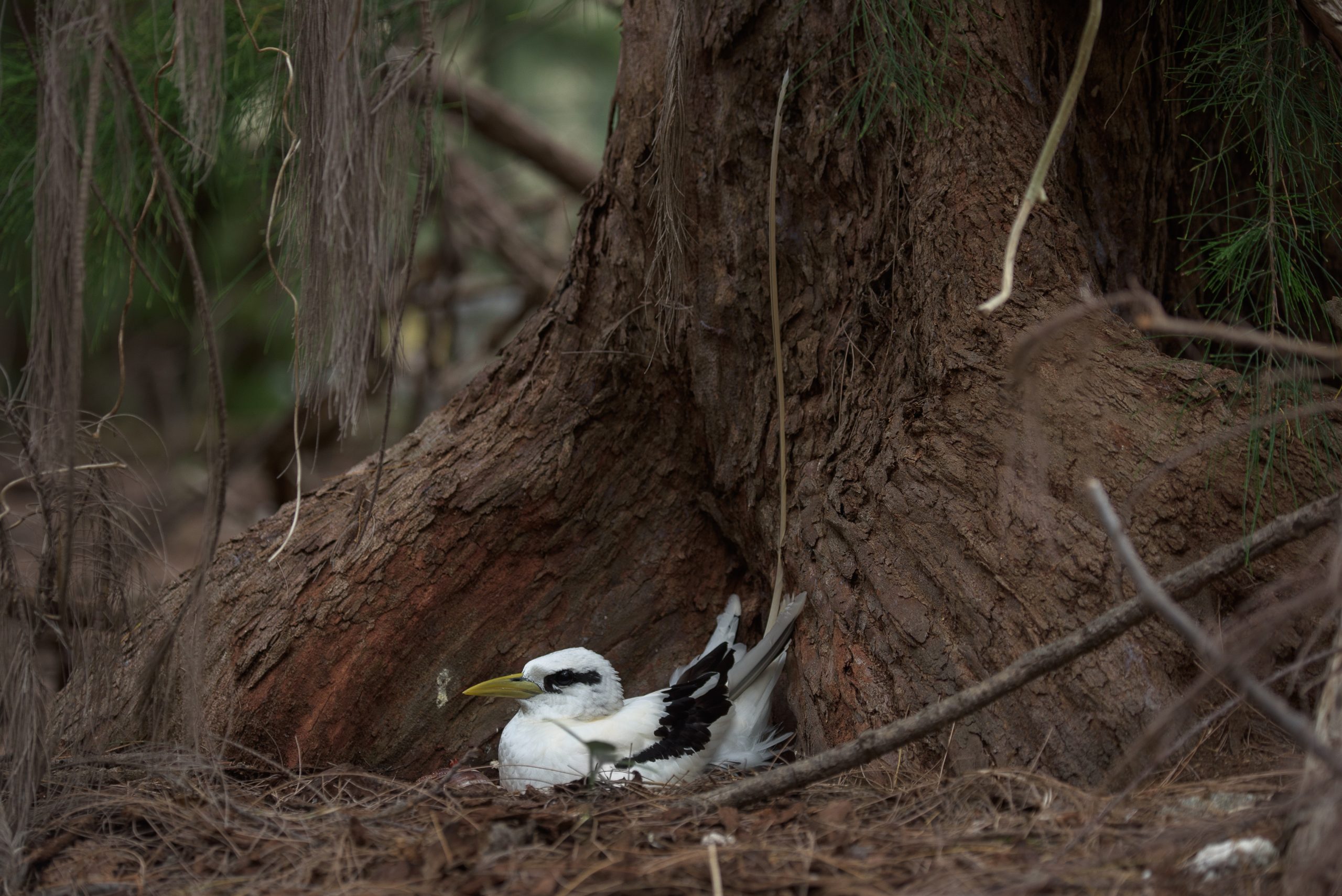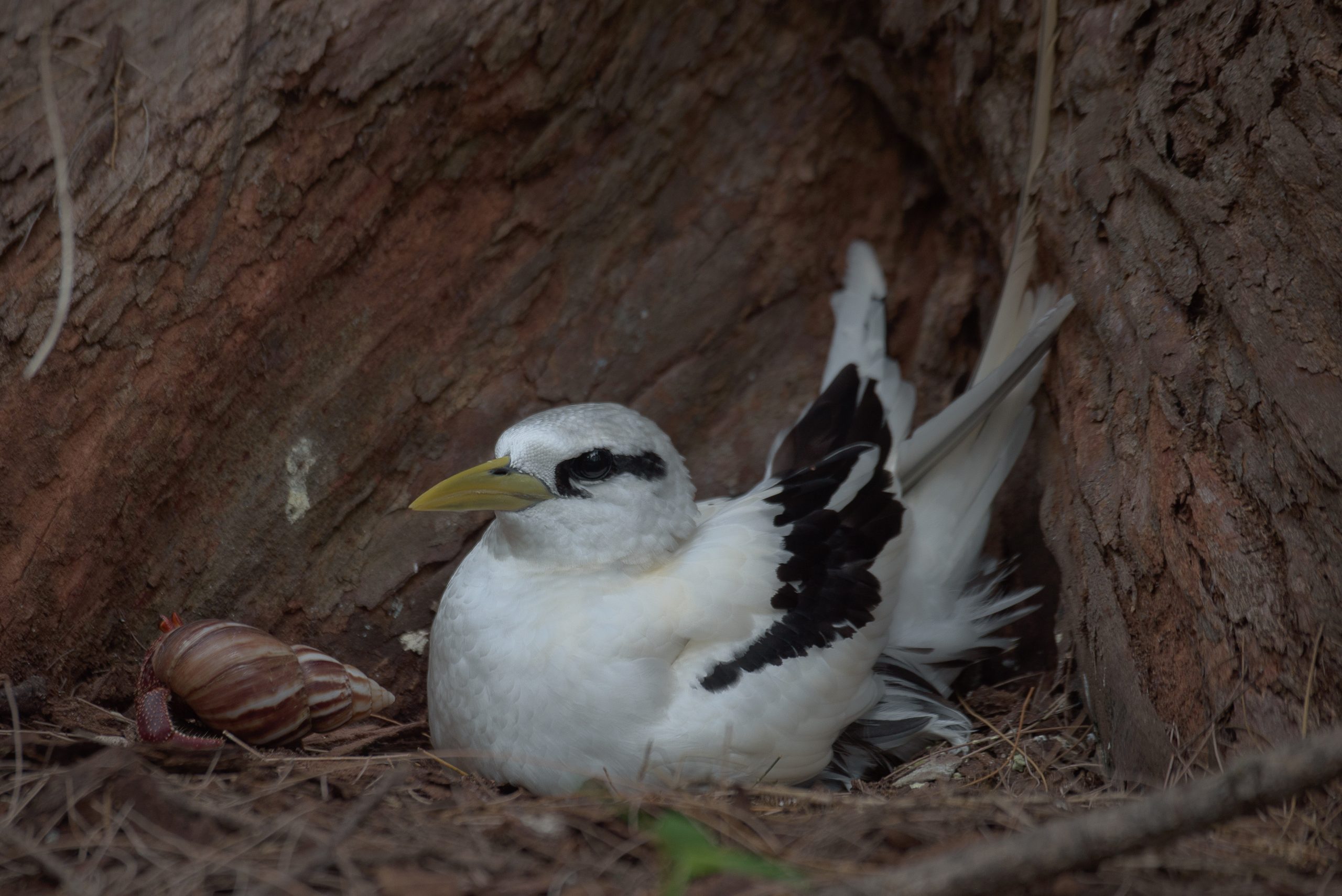Koaʻe Kea

Names
- ʻŌlelo Hawaiʻi: Koa‘e kea
- Common: White-tailed Tropicbird
- Scientific: Phaethon lepturus
Song
Conservation Status
- IUCN Red List Ranking – Least Concern
Species Information

Koaʻe kea or White-tailed Tropicbird. PC: Alex Wang
The koa‘e kea or white-tailed tropicbird is a showy, white seabird (Family: Phaethontidae), related to boobies and frigatebirds. Six koa‘e kea (white-tailed tropicbird) subspecies are recognized; only one (P. l. dorothea) breeds in Hawai‘i. Adult male and females are mostly white, although sometimes with pale pinkish wash, except for a narrow black eye patch, black streak on upper wings, and black on the leading edge of the outer primaries; both sexes have long, narrow, white central tail feathers. Large yellow-green bill; legs and feet are very small. Flight is characterized by rapid wing beats, interspersed with brief periods of gliding. Koa‘e kea (white-tailed tropicbird) usually forage alone, but occasional with members of their same species, most often far from land. They will often follow ships. Koa‘e kea (white-tailed tropicbird) captures prey by plunge diving from 15 to 20 meters (50 – 65 feet) above the water. Diet is poorly known, but includes flyingfish and is likely similar to koa‘e ula or red-tailed tropicbird (P. rubricauda). Koa‘e kea (white-tailed tropicbird) breed in colonies and pairs remain together for years. At the beginning of the breeding season, pairs engage in complex aerial displays. Nests are placed in hard to reach locations on cliffs as well as in caves and tree hollows; nests have little if any material. In Hawai‘i, breeding occurs March through October and a single egg is laid per season. Both parents incubate the egg, and brood and fed the chick. No post-fledging (after birds learning how to fly) care is provided. Based on few data, age at first breeding is likely after fourth year. No data on longevity.
Distribution
Koa‘e kea (white-tailed tropicbird) breed on Midway Atoll and in the MHI at the following locations: Waimea Canyon, Kīlauea Point National Wildlife Refuge, and the Nā Pali Coast on Kaua‘i; Pelekunu Valley, Waikolu, and windward sea cliffs on Moloka‘i; Kaholo Pali, Maunalei Gulch, Hauola Gulch on Lāna‘i; Kīlauea Crater and windward coast on the island of Hawai‘i, and the offshore islet Mokoli‘i. A few pairs nest on southeastern O’ahu. Outside of Hawai‘i, koa‘e kea (white-tailed tropicbird) breed on oceanic islands throughout the Atlantic, Indian, and Pacific oceans as well as the Caribbean. Outside the breeding season, adults are solitary and pelagic, and their range is poorly known.
Habitat
Terrestrial: Koa‘e kea (white-tailed tropicbird) breeds mainly on oceanic islands. Frequently nests in inaccessible crevices or ledges on cliff walls. Outside of Hawai‘i, the species is known to nest in a variety of sites, including caves, tree hollows, and closed-canopy rainforests. Marine: Pelagic and nearshore.
Threats
- Introduced predators. Like all seabirds, adults and nests are susceptible to predation by rats (Rattus spp.) and feral cats (Felis silvestris).
Plans & Projects
Photos
Additional Resources
For more information and references visit the DLNR State Wildlife Action Plan factsheets. DOFAWʻs species pages and State Wildlife Action Plan fact sheets are provided for general information and are not meant to be a citable, original source of data. If you are a student, researcher, or writer looking for a citable source, please explore the references below or find other original data sources, rather than citing these webpages. The references below were provided by the authors of the State Wildlife Action Plan fact sheets at the time of drafting:
- Kushlan JA, et al. 2002. Waterbird Conservation for the Americas: The North American waterbird conservation plan, Version 1 Waterbird Conservation for the Americas, Washington, DC. 78pp. Available at: www.waterbirdconservation.org.
- Lee DS, Walsh-McGehee M. 1998. White-tailed tropicbird (Phaeton lepturus). In The Birds of North America, No. 353 (Poole A, Gill F, editors.). Philadelphia, (PA): The Academy of Natural Sciences; and Washington DC: The American Ornithologists’ Union.
- NatureServe. 2003. Downloadable animal data sets. NatureServe Central Databases. Available at: https://www.natureserve.org/getData/vertinvertdata.jsp (March 10, 2005).
- U.S. Fish and Wildlife Service. 2005. Regional seabird conservation plan, Pacific Region. U.S. Fish and Wildlife Service, Migratory Birds and Habitat Programs, Pacific Region. Portland, (OR): U.S. Fish and Wildlife Service.


